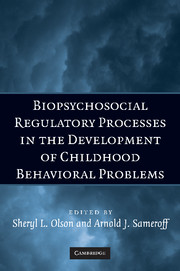Book contents
- Frontmatter
- Contents
- Preface
- Contributors
- 1 Conceptual Issues in Studying the Development of Self-Regulation
- 2 How Gene-Environment Interactions Can Influence the Development of Emotion Regulation in Rhesus Monkeys
- 3 Context Matters: Exploring Definitions of a Poorly Modulated Stress Response
- 4 An Integrative Approach to the Neurophysiology of Emotion Regulation: The Case of Social Withdrawal
- 5 Regulatory Competence and Early Disruptive Behavior Problems: The Role of Physiological Regulation
- 6 Behavior Regulation as a Product of Temperament and Environment
- 7 Self-Regulatory Processes in the Development of Disruptive Behavior Problems: The Preschool-to-School Transition
- 8 Emotional Dysregulation and the Development of Serious Misconduct
- 9 Regulatory Processes in Children's Coping with Exposure to Marital Conflict
- 10 Family Subsystems and Children's Self-Regulation
- 11 Culture and the Development of Regulatory Competence: Chinese–U.S. Comparisons
- 12 Self-Regulation and the Development of Behavioral and Emotional Problems: Toward an Integrative Conceptual and Translational Research Agenda
- Index
- References
8 - Emotional Dysregulation and the Development of Serious Misconduct
Published online by Cambridge University Press: 02 July 2009
- Frontmatter
- Contents
- Preface
- Contributors
- 1 Conceptual Issues in Studying the Development of Self-Regulation
- 2 How Gene-Environment Interactions Can Influence the Development of Emotion Regulation in Rhesus Monkeys
- 3 Context Matters: Exploring Definitions of a Poorly Modulated Stress Response
- 4 An Integrative Approach to the Neurophysiology of Emotion Regulation: The Case of Social Withdrawal
- 5 Regulatory Competence and Early Disruptive Behavior Problems: The Role of Physiological Regulation
- 6 Behavior Regulation as a Product of Temperament and Environment
- 7 Self-Regulatory Processes in the Development of Disruptive Behavior Problems: The Preschool-to-School Transition
- 8 Emotional Dysregulation and the Development of Serious Misconduct
- 9 Regulatory Processes in Children's Coping with Exposure to Marital Conflict
- 10 Family Subsystems and Children's Self-Regulation
- 11 Culture and the Development of Regulatory Competence: Chinese–U.S. Comparisons
- 12 Self-Regulation and the Development of Behavioral and Emotional Problems: Toward an Integrative Conceptual and Translational Research Agenda
- Index
- References
Summary
Emotional dysregulation is a term that is used when aspects of a person's emotional functioning are ineffective or inappropriate or risk compromising the accomplishment of later developmental tasks (Cicchetti, Ganiban, & Barnett, 1991; Cole, Michel, & Teti, 1994; Garber & Dodge, 1991; Keenan, 2000). The term acknowledges that emotions are always regulated (i.e., there is no pure emotion that is unregulated), but that a pattern of emotion regulation has a dysfunctional quality. Although there has been relatively little research on the emotional profiles of children with serious psychological problems, the key symptoms of most childhood disorders feature emotional difficulties, such as hostile defiance, anxiety, angry aggression, tantrums, moodiness, and irritability (Cole et al., 1994; Keenan, 2000). Without the benefit of emotion theory to guide our understanding of the emotional nature of symptoms, it might seem that strong emotions debilitate behavioral functioning.
Contemporary theories, however, regard emotions as adaptive. Emotions are defined as the processes of both appraising circumstances relative to one's well-being and readying to act on circumstances to maintain or regain well-being (e.g., Arnold, 1960; Barrett & Campos, 1987; Ekman, 1994; Frijda, 1986; Lazarus, 1991). This biologically based rapid radar and response system equips us to deal with the ever-changing nature of circumstances and to act without hesitation when necessary (e.g., fleeing from danger). Therefore, emotions motivate action, evolving as a system that is crucial to survival.
- Type
- Chapter
- Information
- Biopsychosocial Regulatory Processes in the Development of Childhood Behavioral Problems , pp. 186 - 211Publisher: Cambridge University PressPrint publication year: 2009
References
- 13
- Cited by



